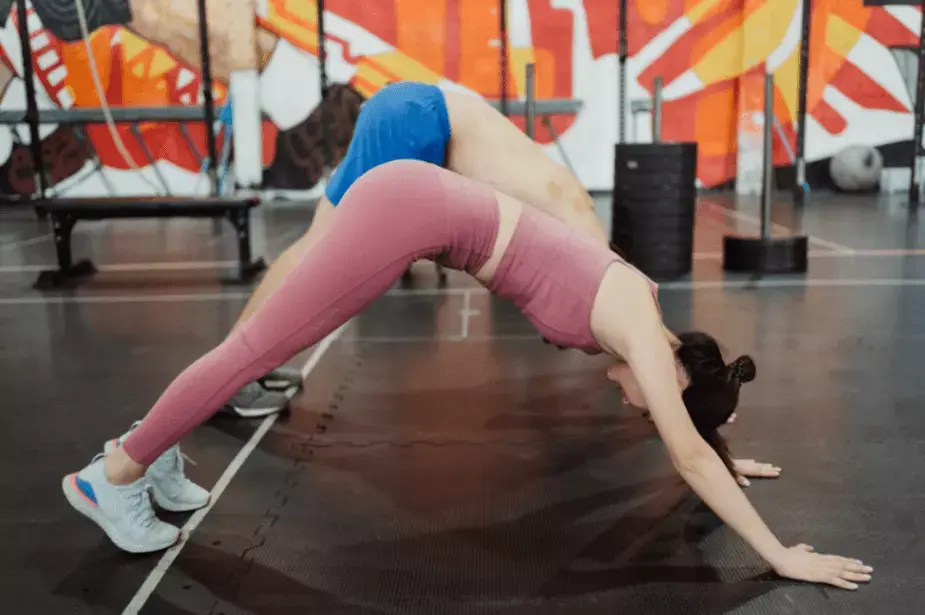Warming up before a workout isn’t just a good idea—it’s your secret weapon for crushing your fitness goals. Whether you’re gearing up for an intense lifting session or a high-energy fitness class, skipping a proper warm-up can lead to unnecessary injuries and hold you back from peak performance.
Many people dive straight into their workouts, eager to push their limits, but neglecting to prepare your upper body can leave you stiff, sore, and underperforming. The solution? Dynamic stretching. It’s not just about flexibility—it’s about activating key muscles, increasing range of motion, and setting yourself up for success.
In this article, we’re breaking down five game-changing dynamic upper body stretches that will take your pre-workout routine to the next level. Add these movements to your warm-up, and you’ll maximize performance while keeping injuries at bay.
Say goodbye to pain and hello to gains—let’s get stretching!
Why is Dynamic Stretching Important?
Dynamic stretching is important for getting your body ready for exercise, especially regarding your upper body. It helps prepare your muscles and joints by promoting blood flow and activating the muscles you’ll be using during your workout. This process essentially wakes up your body, priming it for the physical demands ahead.
Another key benefit is the increase in range of motion. Dynamic stretching improves your flexibility and mobility, allowing your muscles to move through their full range, which can enhance your performance during exercise. When your joints and muscles are activated and flexible, you can move more efficiently and with better form.
Finally, dynamic stretching plays a major role in preventing injuries. By loosening up your muscles and reducing stiffness, dynamic stretches ensure that your muscles are ready for the workout. This lowers the risk of strains, pulls, or other injuries that can occur when muscles are tight and not properly warmed up.
 Dynamic Upper Body Stretches for Warming Up
Dynamic Upper Body Stretches for Warming Up
1. Arm Circles
As a straightforward dynamic stretch, arm circles effectively improve shoulder mobility and engage your upper body muscles prior to working out. To perform the movement, extend your arms straight out to your sides at shoulder height. Begin making small, controlled circles in the forward direction, gradually increasing the size of the circles. After a set number of repetitions, reverse the motion and perform the same movement in the backward direction.
This movement helps to loosen up the shoulder joints, which can become stiff or tight before physical activity. The circular motion of arm circles engages the muscles in and around the shoulder joint, allowing for a greater range of motion. This is important for exercises that rely on shoulder flexibility, such as weightlifting or push-ups.
In addition to increasing mobility, arm circles activate key upper body muscles, particularly the shoulders, arms, and even parts of your upper back. By engaging these muscles dynamically, you’re preparing them for more intense movements later in your workout.
2. Torso Twists
Torso twists are an excellent dynamic stretch that effectively engages your core muscles while improving spinal mobility. This movement is particularly useful for warming up your upper body because it engages the muscles around your spine and midsection, preparing you for exercises that involve rotation or stability in the core.
There are two common variations of torso twists: standing torso twists and seated torso twists. In a standing position, you rotate your upper body from side to side while keeping your feet planted. This version is more dynamic and is often used in warm-ups when you want to engage your entire body. On the other hand, seated torso twists are performed while sitting, which limits the involvement of the legs and forces a more focused engagement of the core and spine. Seated twists are useful when you want to isolate the upper body and spine or if you need a more controlled movement.
Both versions of torso twists are excellent for warming up the spine. By gently rotating your torso, you promote greater flexibility in your spine and core, allowing for better stability and mobility during exercises that require upper body movement. This makes torso twists an essential part of any upper body warm-up routine, especially if your workout involves weightlifting, throwing, or any movements that rely on a stable core.
3. High Knees with Arm Swings
High Knees with Arm Swings are an excellent way to warm up your upper and lower body simultaneously. This movement combines the lower body action of lifting your knees high toward your chest, while your arms swing in time with each step. The high knees engage your core, quadriceps, and hip flexors, while the arm swings activate your shoulders, biceps, and triceps. By working both areas at once, you increase overall coordination and make sure that your entire body is primed for more intense exercise.
To make the most of this dynamic movement, it’s important to coordinate your breath with your movement. Inhale as you raise your knees and swing your arms, and exhale as you lower them. This helps you maintain a steady rhythm, which is key to keeping the movement controlled and effective.
You can also adjust the intensity of High Knees with Arm Swings by changing the speed or range of the arm movements. Swinging your arms faster will engage your shoulders more, while larger arm swings will stretch and activate different muscles in your shoulders and upper back. This makes the movement more versatile and customizable for your specific warm-up needs.
4. Shoulder Rolls
Shoulder rolls are a simple yet effective way to loosen up your shoulder joints before you engage in more intense physical activity. They help to warm up the muscles around the shoulder, which is important for preventing strain and ensuring smoother movements during your workout.
To perform shoulder rolls, you can move in two directions:
- Forward shoulder rolls: These engage the front part of the shoulder muscles, also known as the anterior deltoids. By rolling your shoulders forward in a circular motion, you focus on stretching and warming up these muscles.
- Backward shoulder rolls: This motion targets the rear shoulder muscles, or posterior deltoids, and helps improve your posture by counteracting the forward-leaning tendency many people have during the day.
Both directions work together to increase blood flow and boost mobility in your shoulders, making them more flexible and ready for larger, more intense movements.
5. Inchworms
Engaging in inchworms before exercise activates your shoulders, arms, and core, making it an excellent full-body dynamic stretch for upper body warm-ups. This movement is functional and purposeful, as it both stretches and strengthens key muscle groups.
To perform inchworms, start in a standing position, then bend at your hips to place your hands on the floor and walk them forward into a plank position. Once in the plank, engage your core and shoulders, then walk your feet toward your hands to return to the starting position. By repeating this movement, you engage your upper body while simultaneously stabilizing your core. This helps warm up your shoulders and arms, preparing them for more intense exercise.
There are also several variations of inchworms that can adjust the difficulty level, depending on your fitness:
- For beginners: Bend your knees slightly when walking your hands forward. This reduces the strain on your hamstrings and makes the movement more accessible.
- For advanced individuals: Add a push-up at the plank position to further activate your upper body muscles.
Tips for Effective Dynamic Stretching
Dynamic stretching is most effective when done with proper technique and consistency. To make the most of your warm-up and ensure that you’re preparing your upper body for exercise, it’s important to focus on a few key areas.
First, maintaining proper form is essential. When stretching dynamically, your goal is to activate and prepare your muscles, not to overstretch or strain them. Pay attention to your posture and alignment during each movement. For example, with arm circles, avoid overextending your shoulders; instead, make controlled, smooth rotations. Keeping your movements intentional and steady will help you avoid injury while maximizing the benefits of each stretch. Stretching apps, such as WeStretch, can help you maintain proper form. The platform features two virtual guides, Ada and Adam, who provide you with a live class on proper form, ensuring that you can perform each movement correctly and safely.
As your muscles warm up, gradually increase the intensity and range of motion. Start with smaller, slower movements and progressively build up to larger, more dynamic motions. This allows your muscles and joints to ease into the stretches, reducing the risk of pulling or straining a muscle. For example, when doing torso twists, begin with a gentle range of motion and increase the twist as your back and core become more flexible.
Consistency is key to seeing long-term benefits. Incorporate dynamic stretching into your regular pre-workout routine to help improve your performance and reduce injury risk over time. Dynamic stretches should be done before every workout, not just on intense training days. By consistently including movements like shoulder rolls or inchworms in your warm-up, you’ll prepare your body for the physical demands of your workout, whether you’re lifting weights or doing cardio. You can use WeStretch to maintain consistency; WeStretch’s dashboard and leaderboard features take the strain off your mind and let you focus on the stretches themselves.
These tips will help ensure that you’re getting the most out of your dynamic upper body stretches and set you up for a more effective workout.
Exercise Smarter with WeStretch: Your All-in-One Stretching Assistant
A consistent full-body stretching routine is essential for improving flexibility, supporting injury prevention, and enhancing overall well-being. Carefully following simple yet effective stretches targeting the hamstrings, hip flexors, back, quads, chest, and shoulders, individuals of any fitness level can reap the benefits.
Regular stretching, with attention to proper form and consistency, can help you move more freely, recover faster, and feel better in everyday activities.
Looking for a way to add some fun to your stretching routine? Check out WeStretch—an app that’s like your own personal stretch coach! With tailored plans, easy-to-follow demos, and progress tracking, it’s got everything you need to keep you limber and on point. Ready to get flexible? Sign up today and let’s get stretching!
FAQ
What are dynamic upper body stretches?
Dynamic upper body stretches involve controlled movements to enhance flexibility and prepare muscles for activity. Examples include arm circles, shoulder rolls, and torso twists. Perform these exercises for up to 30 seconds each to warm up your upper body effectively.
How can dynamic upper body stretches benefit my workout?
Dynamic upper body stretches improve flexibility, increase blood flow, and enhance mobility, leading to better workout performance. Try arm circles, torso twists, or overhead reaches before your workout to prepare your muscles and joints, reducing the risk of injury and improving your range of motion.
Which muscles are targeted by these dynamic stretches?
Dynamic stretches target various muscle groups depending on the movement. For instance, arm circles activate shoulders and upper arms, while torso twists work the core muscles. Each stretch prepares these muscles for activity.
How long should I perform each stretch?
Hold each stretch for up to 30 seconds, repeating 2-4 times. For example, stretch your hamstrings by reaching for your toes and holding for up to seconds or perform a chest stretch by clasping your hands behind your back.
Can I do dynamic upper body stretches without prior exercise experience?
Yes, you can do dynamic upper body stretches without prior experience. Try arm circles, torso twists, and shoulder rolls. Start slowly, aim for 10-15 repetitions, and increase intensity gradually to enhance flexibility and warm up your muscles safely.






